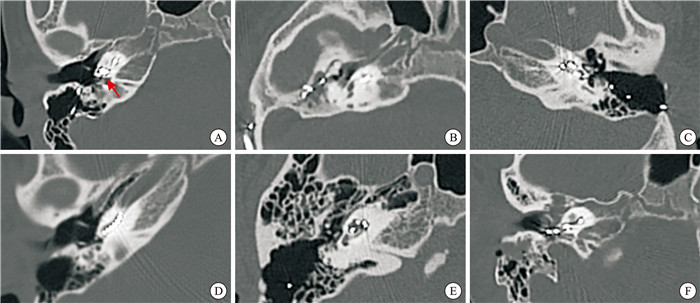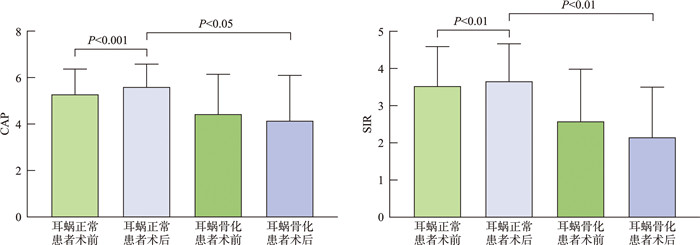Analysis of cochlear reimplantation surgery and factors influencing postoperative auditory and speech function
-
摘要: 目的 总结本中心在人工耳蜗再植入(cochlear reimplantation,CRI)方面的经验,分析CRI手术成功率及术后听觉言语康复效果的影响因素,提高CRI的成功率。方法 回顾性研究从2001至2022年进行CRI的76例患者的再植入原因、手术情况、植入失败情况和原因分析。术后采用听觉和言语表现用听觉行为分级(categorical auditory performance,CAP)和言语可懂度评级(speech intelligibility rating,SIR)量表评估患者听觉言语功能,并与术前进行比较。结果 7例患者来自本中心1 126例连续的患者队列,69例来自其他人工耳蜗中心。设备故障是最常见的CRI原因(68/76),其余包括皮瓣并发症(3/76)、磁铁移位(3/76),继发性脑膜炎(1/76)和植入体周围异物(1/76)。31.6%(24/76)的患者CRI术后听觉言语功能获得改善,63.2%(48/76)的患者术后无变化,5.2%(4/76)的患者CAP和SIR评分下降。发生耳蜗骨化的7例患者术后CAP、SIR评分总体低于耳蜗正常患者,是影响手术成功率及听觉言语疗效的主要因素。结论 CRI手术是一项具有挑战性但相对安全的手术,大多数移植患者术后预后良好。耳蜗骨化纤维化是导致植入失败和影响听觉言语功能的主要原因。因此,首次CI手术的耳蜗微创操作对于降低CRI手术难度,提高CRI成功率和术后听觉言语功能具有积极意义。Abstract: Objective The aim of this study was to present an institution's experience with cochlear reimplantation(CRI), to assess surgical challenges and post-operative outcomes and to increase the success rate of CRI.Methods We retrospectively evaluated data from 76 reimplantation cases treated in a tertiary center between 2001 and 2022. Clinical features include caused of CRI, type of failure, surgical issues, and auditory speech performance were analyzed. Categorical Auditory Performance (CAP) and Speech Intelligibility Rating (SIR) scores were used to evaluate pre-and post-CRI outcomes. Our center's consecutive cohort of 1 126 patients had seven patients, while 69 patients were from other cochlear implant centers. Device failure was the most common cause of CRI(68/76), with the remaining cases including flap complications(3/76), magnet displacement(3/76), secondary meningitis(1/76), and foreign bodies around the implant(1/76). Postoperative auditory and speech outcome improved in 31.6%(24/76) of patients, remained unchanged in 63.2%(48/76), and decreased in CAP and SIR scores in 5.2%(4/76) of patients. Postoperatively, the seven patients with cochlear ossification and fibrosis scored lower on the overall CAP and SIR scale than non-ossification individuals, which is a significant factor in surgical success rates and auditory-speech outcomes.Conclusion CRI surgery is a challenging but relatively safe procedure, and most reimplanted patients experience favorable postoperative outcomes. Medical complications and intracochlear damage are the main causes of poor postoperative results. Therefore, minimally invasive CI has a positive significance for reducing the difficulty of CRI surgery and improving the CI performance.
-

-
表 1 耳蜗骨化纤维化患者具体情况分析
序号 CRI年龄/年 CI与CRI间隔时间/年 植入体型号 CRI原因 术中情况 植入情况 CRI前CAP/SIR CRI后CAP/SIR 9 6 3.6 NurotronCS-10A DF 严重耳蜗骨化,打开耳蜗底转,无法找到骨性蜗管 植入失败 6/4 2/1 10 8 6.0 NurotronCS-10A DF 严重耳蜗骨化,打开耳蜗底转,清理增生骨质 部分植入(蜗外4个电极) 1/0 1/0 47 9 7.8 NurotronCS-10A DF 严重耳蜗骨化,打开部分耳蜗底转,清理增生骨质 部分植入(蜗外2个电极) 4/2 5/3 48 5 2.4 NurotronCS-10A DF 耳蜗纤维化 全部植入 5/3 6/3 61 16 8.0 NurotronCS-10A DF 耳蜗纤维化 全部植入 7/5 7/5 64 10 5.1 NurotronCS-10A DF 耳蜗纤维化 全部植入 4/2 5/2 75 23 10.0 NurotronCS-10A DF 耳蜗造口周围骨化增生,扩大耳蜗造口,清理增生骨质 部分植入(蜗外1个电极) 6/4 6/4 DF:设备故障。 表 2 影响CRI术后听觉言语效果的因素分析
条件 CAP SIR R2 P R2 P 听觉剥夺时间 0.010 9 0.516 6 0.010 1 0.531 7 耳蜗骨化 0.090 5 0.009 2 0.169 2 0.000 3 植入状态 0.301 9 <0.001 0.391 1 <0.001 首次植入年龄 0.006 6 0.492 5 0.000 2 0.899 2 CI与CRI手术间隔 0.005 2 0.542 4 0.013 3 0.327 4 耳聋原因 0.000 1 0.918 4 0.018 1 0.255 9 产品设计 0.002 5 0.674 5 0.006 9 0.483 9 再植入原因 0.046 3 0.067 5 0.014 9 0.303 6 性别 0.001 3 0.762 4 0.001 5 0.739 5 -
[1] Wang JT, Wang AY, Psarros C, et al. Rates of revision and device failure in cochlear implant surgery: a 30-year experience[J]. Laryngoscope, 2014, 124(10): 2393-2399. doi: 10.1002/lary.24649
[2] Lane C, Zimmerman K, Agrawal S, et al. Cochlear implant failures and reimplantation: a 30-year analysis and literature review[J]. Laryngoscope, 2020, 130(3): 782-789. doi: 10.1002/lary.28071
[3] Lehnhardt E. Intracochlear placement of cochlear implant electrodes in soft surgery technique[J]. HNO, 1993, 41(7): 356-359.
[4] von Ilberg C, Kiefer J, Tillein J, et al. Electric-acoustic stimulation of the auditory system. New technology for severe hearing loss[J]. ORL J Otorhinolaryngol Relat Spec, 1999, 61(6): 334-340. doi: 10.1159/000027695
[5] O'Donoghue GM, Nikolopoulos TP. Minimal access surgery for pediatric cochlear implantation[J]. Otol Neurotol, 2002, 23(6): 891-894. doi: 10.1097/00129492-200211000-00014
[6] 戴朴, 宋跃帅. 人工耳蜗植入微创进路手术的临床应用[J]. 中华耳鼻咽喉头颈外科杂志, 2010, 45(10): 800-802. doi: 10.3760/cma.j.issn.1673-0860.2010.10.004
[7] 戴朴, 蒋刈, 高松. 微创人工耳蜗植入[J]. 中国耳鼻咽喉颅底外科杂志, 2016, 22(5): 341-344.
[8] 宋跃帅, 王振晓, 谢静, 等. 人工耳蜗再植入的病因及治疗[J]. 中国耳鼻咽喉头颈外科, 2018, 25(11): 588-590.
[9] 孙春晖, 温立婷, 陈俊, 等. 34例人工耳蜗植入术后再次手术患者的原因和处理方法分析[J]. 听力学及言语疾病杂志, 2020, 28(1): 61-66.
[10] Yeung J, Griffin A, Newton S, et al. Revision cochlear implant surgery in children: Surgical and audiological outcomes[J]. Laryngoscope, 2018, 128(11): 2619-2624. doi: 10.1002/lary.27198
[11] Pamuk AE, Pamuk G, Jafarov S, et al. The effect of cochlear implant bed preparation and fixation technique on the revision cochlear implantation rate[J]. J Laryngol Otol, 2018, 132(6): 534-539. doi: 10.1017/S0022215118000609
[12] Sunde JM, Webb JB, Moore PC, et al. Cochlear implant failure, revision, and reimplantation[J]. Otol Neurotol, 2013, 34(9): 1670-1674. doi: 10.1097/MAO.0000000000000079
[13] Liu HT, Yao XY, Kong WL, et al. Cochlear reimplantation rate and cause: a 22-year, single-center experience, and a meta-analysis and systematic review[J]. Ear Hear, 2023, 44(1): 43-52. doi: 10.1097/AUD.0000000000001266
[14] Blanc F, Blanchet C, Sicard M, et al. Audiological outcomes and associated factors after pediatric cochlear reimplantation[J]. J Clin Med, 2022, 11(11): 3148. doi: 10.3390/jcm11113148
[15] Chen JY, Chen B, Shi Y, et al. A retrospective review of cochlear implant revision surgery: a 24-year experience in China[J]. Eur Arch Otorhinolaryngol, 2022, 279(3): 1211-1220. doi: 10.1007/s00405-021-06745-1
[16] Gumus B, ncesulu AS, Kaya EC, et al. Analysis of cochlear implant revision surgeries[J]. Eur Arch Otorhinolaryngol, 2021, 278(3): 675-682. doi: 10.1007/s00405-020-06121-5
[17] Moberly A, Welling D, Nittrouer S. Detecting soft failures in pediatric cochlear implants: relating behavior to language outcomes[J]. Otol Neurotol, 2013, 34(9): 1648-1655. doi: 10.1097/MAO.0b013e3182a0036c
[18] Gawęcki W, Karlik M, Borucki Ł, et al. Skin flap complications after cochlear implantations[J]. Eur Arch Otorhinolaryngol, 2016, 273(12): 4175-4183.
[19] Ikeya J, Kawano A, Nishiyama N, et al. Long-term complications after cochlear implantation[J]. Auris Nasus Larynx, 2013, 40(6): 525-529.
[20] Terry B, Kelt RE, Jeyakumar A. Delayed complications after cochlear implantation[J]. JAMA Otolaryngol Head Neck Surg, 2015, 141(11): 1012-1017.
[21] Bi QL, Chen ZY, Lv Y, et al. Management of delayed-onset skin flap complications after pediatric cochlear implantation[J]. Eur Arch Otorhinolaryngol, 2021, 278(8): 2753-2761.
[22] Öz O, De Ceulaer G, Govaerts PJ. Speech audiometrical results before and after reimplantation of cochlear implants[J]. Ear Hear, 2022, 43(2): 669-675.
[23] Thompson NJ, Dillon MT, Bucker AL, et al. Electric-acoustic stimulation after reimplantation: hearing preservation and speech perception[J]. Otol Neurotol, 2019, 40(2): e94-e98.
[24] Dietz A, Linder P, Iso-Mustajärvi M. A state-of-the-art method for preserving residual hearing during cochlear implant surgery[J]. J Vis Exp, 2023(195): e64021.
[25] 鲁兆毅, 潘滔, 王宇, 等. 32例儿童人工耳蜗再植入的术中问题及应对措施[J]. 临床耳鼻咽喉头颈外科杂志, 2023, 37(3): 218-221. doi: 10.13201/j.issn.2096-7993.2023.03.012
[26] 韩鹏, 牛晓蓉, 杜小滢, 等. 人工耳蜗植入术后的颞骨病理变化及预防措施[J]. 中华耳鼻咽喉头颈外科杂志, 2016, 51(10): 786-791.
[27] 刘军, 李万鑫. 人工耳蜗植入的残余听力保留技术[J]. 中国听力语言康复科学杂志, 2017, 15(1): 1-5.
[28] Somdas MA, Li PMMC, Whiten DM, et al. Quantitative evaluation of new bone and fibrous tissue in the cochlea following cochlear implantation in the human[J]. Audiol Neurootol, 2007, 12(5): 277-284.
[29] Nadol JB Jr. Patterns of neural degeneration in the human cochlea and auditory nerve: implications for cochlear implantation[J]. Otolaryngol Head Neck Surg, 1997, 117(3 Pt 1): 220-228.
[30] Shepherd RK, Clark GM, Xu SA, et al. Cochlear pathology following reimplantation of a multichannel scala tympani electrode array in the macaque[J]. Am J Otol, 1995, 16(2): 186-199.
-

计量
- 文章访问数: 191
- 施引文献: 0




 下载:
下载:
